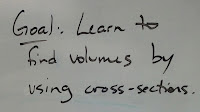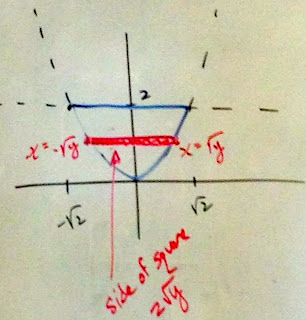Next we looked at a video by ViHart about a mysterious number called Wau. She talked about all of wau's properties which were numerous. There was a bit of confusion in the room until we realized wau was just 1.
Then O'B spoke some pretty powerful words: "We're done. We've finished calculus." Well, we've almost finished calculus. This led O'B into a discussion about the weeks between now and the AP Test. All of this info can be found on the iCal, but I'll summarize:
- O'B is leaving and will not be here next week. IW 6 and 7 will be assigned while he is away. They are a set of FRQ's with answers. Make sure you actually do the FRQ's because there will be a quiz the Friday (March 22) he gets back on IW 5 and the FRQ's. There will be NO number changes, which means we can't use notes.
- If you have questions about IW 6 or 7, just post them up and O'B will get to them as soon as he can. We will have 3 hours of in class time to get these done. Thats double the amount of time we need.
-March 26 (tuesday): We have a test. IW's 5-8 are due.
-March 29 (friday): Supercorrections are due.
- April 3: The first grade of Q4 will be the follow up test!
- Aril 5: The first quiz of Q4 will be trig values. This is not timed and is re-takable up to 100%
-April 9 and 11: Quizzes on FRQ's. NO number changes. Do IW and you'll be set. Closed notes.
-April Break: Optional FRQ's
- April 24 and 26: Multiple choice section of full AP practice test
-April 30 and May 2: FRQ section of full AP practice test
-May 6: Supercorrections due for the above test
-Tuesday May 7: Deadline for all late work.
-Wednesday May 8: AP TEST
- No work will be accepted after the AP test. It's a waste of everyone's time. We will then do a project as our final exam and we are allowed to work in partners or threesomes.
Now on to IW 5. Although the link for this IW can be found on the ical, make sure you write all the answers out in your notebook, not just on the handout.
IW#5 Question 31:
Find the volume of the solid generated by revolving the region bounded by the parabola y=x^2 and the line y=1 about
(a) the line y=1
(b) the line y=2
(c) the line y=-1
Here is a graph of this scenario courtesy of Connor Lane:
A)
So, in part a, we are revolving this around the line of y=1 which happens to be one of the boundaries of the shaded region. This means that when we rotate it, it's radius will just be the distance between the line y=1 and the curve y=x^2. So, this gives us:
Notice that the limit is just from 0 to 1. Even though the shaded region goes from -1 to 1, we compensate by doubling the integral since it is symmetric about the y axis.
B)
Okay, so now we're rotating it about the line y=1. When we take a cross section of this, it is going to give us a washer. This means we need to subtract the inner circle from the outer circle to get the area of the washer, then multiply it by that small thickness, dx.
C)
Now we are rotating it about the line y=-1. In part B, the outside of the solid had a curve to it, while the inside was flat. It made a roller blade-esque wheel. However, now the outside radius remains the same, while the inside radius is changing. So, we have to take the big radius that is formed between the line y=1 and y=-1 and subtract the little radius from it. This little radius is changing and is formed between y=x^2 and y=-1
Next we looked at #1 from IW 5
Find the volume of the solid with semicircular cross sections whose base is in the xy-plane between the x-axis and the curve y=sqrt(x) over [0,9]. See the visualization here.
Remember that the area of a semi circle is just half of the area of a circle. So, (1/2)πr^2.
Here is a graph of what we're looking at:
So, as you can see, the diameter will be changing. And remember, we're interested in the radius so we'll have to split the diameter in two! This gives us:




































